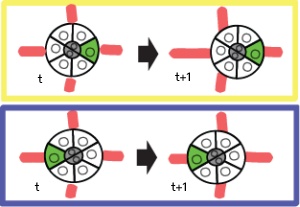
In collective migration, the presence of one cell in an “ON” state (here shown as green) can direct the movement of a cell group; yellow box: movement to the right; blue box: movement to the left.
© 2012 National Academy of Sciences
Cells move in groups over long distances within the body under many different settings, including embryonic development, wound healing and cancer spread. Precisely how these cells are able to collect and process information that guides them to their destination, however, is not fully understood. Pernille Rørth and co-workers at the A*STAR Institute of Molecular and Cell Biology have now shed new light on this cellular activity, using the migration of border cells found inside the ovary of the fruit fly as a model. Significantly, the researchers showed that border cells process key information such as the direction of migration collectively, rather than individually.
Border cells migrate toward the oocyte during oogenesis, and typically travel in groups of 6–8. Their direction of motion is guided by ligands in the oocyte, which act redundantly on two receptors: PDGF/VEGF-related receptor (PVR) and epidermal growth factor receptor (EGFR). Rørth and her team created a cluster of border cells that lack guidance, and then introduced a border cell with higher, but nonlocalized, signal to the cluster. They found that the cluster of border cells moved in the direction of the ‘high signal’ cell (see image), even in the absence of ligands.
Besides ligands, local activation of Rac has been shown to be another mechanism for steering border cell migration. Rørth and her team genetically modified the border cluster so that the cells expressed light-activatable Rac, and then used light to “turn on” just one cell. The results showed that a border cell with higher Rac activity is able to steer other border cells to their destination during migration. They concluded that “what matters is which cell is activated, not where in the cell activation occurs.”
Recognizing the collective effort of migratory cells in processing guidance information is of great interest as it impacts the very definition of guidance information. In addition to the signal transduction mechanisms traditionally associated with guided eukaryotic cell migration, differences in gene expression or metabolite levels must now also be considered. Such mediators had formerly been discounted because they lack spatial information at the single-cell level. Rørth and her team suggest that this collective guidance might exist on top of the well-established single cell guidance system in order to allow the averaging of signal input over longer time-scales or larger areas.
The A*STAR-affiliated researchers contributing to this research are from the Institute of Molecular and Cell Biology.



